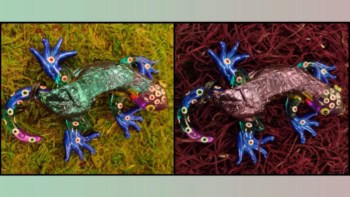
Scientists in France have developed a tiny X-ray detector at the tip of an optical fibre. By combining a nano-optical antenna (NOA) with indirect detection methods, the team has created a device that is only a few tens of microns in diameter. It could therefore have applications in medical endoscopy dosimetry.
Many of today’s X-ray detectors rely upon indirect measurements, whereby a scintillator first converts X-ray energy into light. The photons then travel through optical fibres to a camera or photodetector. While this set-up is widely used in medicine and industry, the machines are cumbersome and creating a small-scale version is challenging. The quantity of X-rays detected is dependent upon the size of the scintillator and the resulting photons are emitted in all directions. Therefore, a small scintillator produces very few photons and the likelihood of them emitting in the direction of the camera is low.
To overcome this problem, Thierry Grosjean, from the University of Burgundy–Franche-Comté in France, and colleagues, incorporated a nano-optical antenna (NOA) between a small scintillator cluster and an optical fibre. Analogous to a microwave horn antenna, a NOA can direct light. So, when an X-ray hits the tiny scintillator cluster, the light emitted can be directed down a thin optical fibre to the camera, thereby increasing the amount of photons detected.
Tiny antenna
The NOA is a miniature horn antenna – it contains a flared wave guide that amplifies a dipolar signal and directs it into a linear waveguide. To create the device, the team grew a 38 μm-long polymer microtip (tip radius 1 μm) at the end of a thin optical fibre. The scintillation cluster was then grafted onto the tip. To prevent visible light from entering the system, a thin layer of aluminium and titanium was applied to its surface. “Such a cluster-to-fibre coupling enhancement enables the realization of X-ray detectors at the end of a narrow single-mode fibre – 125 μm outer diameter in our study, or less,” explains Grosjean.
As well as miniaturizing X-ray detection, a key challenge was to design a device that could be made at low-cost and has the potential to be mass-produced. The researchers point out that the resulting detectors are inexpensive to make and do not require clean-room processes to be fabricated.
The researchers have tested their device for soft X-rays (low energy radiation around 10 keV). They have achieved a spatial resolution in the order of 1 μm, although they hope to improve this to 100 nm in future work to distinguish chemical components during low-energy X-ray scanning microscopy.
Endoscopic dosimeter
“The next step will be to demonstrate our concept with high-energy X-rays for medical applications,” says Grosjean. The compact nature of the device means it could be incorporated into endoscopy techniques and used to measure radiation exposure from inside the body during radiotherapy cancer treatment. To proceed with the work, the group has applied for funding from the French National Research Agency and hopes to produce a market-ready prototype within three years.
“The compactness of our sensor is unprecedented,” Grosjean concludes, “Our nano-optically driven technology is totally new.” The work is presented in The Optical Society journal Optics Letters.



